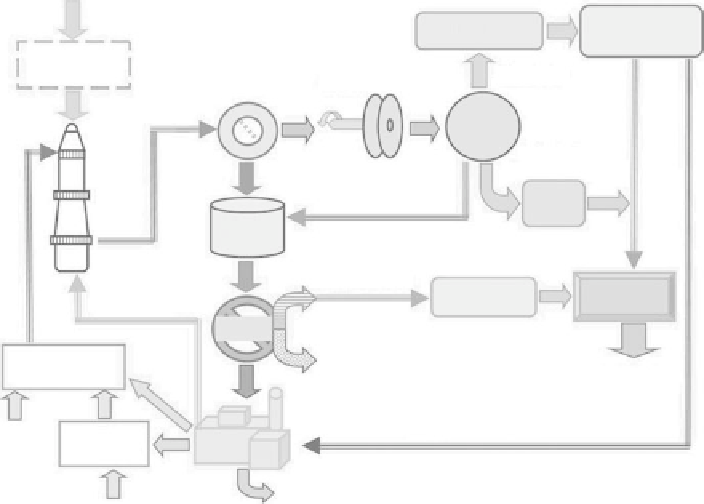Environmental Engineering Reference
In-Depth Information
Wood
chips
Impregnation
(optional)
Saccharification
Fermentation
Substrate
Filtration
Wa shing
Substrate
(alternative)
SSF
Spent
liquor
Hemicellulose
Steam/hot
water
Fermentation
Distillation
Liquor
preparation
Lignosulfonate
Ethanol
Base
(Na, Mg,
NH
4
, Ca)
Lignin residue
SO
2
generator
Heat/chemical
recovery
Steam/electricity
Sulfur/FeS
FIGure 15.5
A schematic process flow diagram of the SPORL.
15.6.2.3 sulfite Pretreatment—sPorl
The recently developed SPORL process (Wang et al. 2009; Zhu et al. 2009) is based on the funda-
mental understanding of sulfite wood pulping. The degrees of hemicellulose dissolution, cellulose
depolymerization, and lignin sulfonation and condensation are controllable by varying pulping con-
ditions, such as temperature and pH (Yorston 1942; Hall and Stockman 1958; Bryce 1980). By prop-
erly controlling reaction temperature, pH, and time, lignocellulose recalcitrance can be removed
through a mild sulfite pretreatment process.
A schematic process flow diagram of the SPORL is shown in Figure 15.5. Wood chips first react
with a solution of sodium bisulfite (or calcium or magnesium or other bisulfite) at 160-190°C and
pH 2-5 for about 30 min and then are fiberized using a disk refiner to generate fibrous substrate for
subsequent saccharification and fermentation. The removal of the recalcitrance of lignocellulose by
SPORL is achieved by the combined effect of dissolution of hemicelluloses, depolymerization of
cellulose, partial delignification (less than 30%), sulfonation of lignin, and increasing surface area
by defiberization through disk refining. Lignin sulfonation increased the hydrophilicity of SPORL-
pretreated substrates and may have promoted the enzyme processes. The pretreatment liquor to
biomass ratio is typically in a range of 2-3, significantly lower than that used in dilute acid and
organosolv processes. Therefore, SPORL can produce a relatively concentrated hemicellulose sugar
stream. The dissolved hemicellulose stream (a mixture of hexoses and pentoses) can be further
fermented to ethanol. The fermentation of spent sulfite pulping liquor (SSL) has been in industrial
practice for commercial cellulosic ethanol production for decades (Helle et al. 2008). The dissolved
lignin sulfonate or five-carbon hemicellulose sugars can be used to produce value-added co-prod-
ucts that can be directly marketed and has been practiced in the industry. Therefore, SPORL has the
advantage of valuable co-product commercial pathways from dissolved hemicellulsoe sugars and
lignin, important to the economics of the process.
Typical pretreatment conditions of SPORL are temperatures of 170-190°C and pH 2-5. For labora-
tory batch operation, retention time is about 30 min. The bisulfite charge on biomass depends on the

